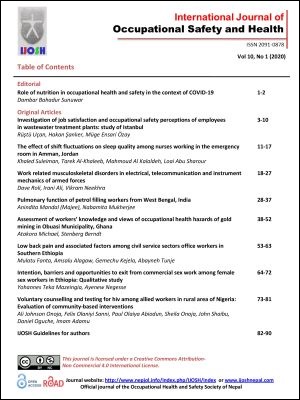Voluntary Counselling and Testing for HIV Among Allied Workers in Rural Area of Nigeria: Evaluation of Community-Based Interventions
DOI:
https://doi.org/10.3126/ijosh.v10i1.29190Keywords:
Voluntary counselling and testing, HIV/AIDS, Intervention programme, Voluntary counselling and testing, HIV/AIDS, Intervention programmeAbstract
Background: Knowledge of human immunodeficiency virus status is a key tool in the fight against the spread of the human immunodeficiency virus epidemic.
Objectives: This study sought to evaluate the impact of community-based intervention towards the prevention and control of human immunodeficiency virus on the voluntary testing for human immunodeficiency virus among allied workers in rural Bonny Kingdom of Rivers, State, Nigeria.
Methods: The study comprised two quantitative surveys; the baseline survey conducted before a three years human immunodeficiency virus prevention intervention programs and the post-intervention survey conducted after the interventions. A structured questionnaire was employed to collect information from a representative sample of the allied workers aged 15–49 years. The questionnaire item for this survey is broadly divided into six categories comprising the basic socio-demographic information, the knowledge of HIV testing, desire for HIV testing, self and solution efficacy; access to products and services including voluntary counselling and testing. Data were analyzed using SPSS version 25.0.
Results: The study comprised 419 participants in the baseline and 587 in the post-intervention survey. The overall knowledge of voluntary counselling and testing services was 76.8% of which 37.5% have been tested and 88.9% of which 68.0% have been tested at both surveys. Three of every 5(67.0%) had the desire to be tested at baseline while- 4 of every 5(81.1%) were willing to be tested at post-intervention. The major reasons for unwillingness to be screened include poor perception about voluntary counselling and testing and feeling of not being at risk. The prevalence of human immunodeficiency at baseline was 8.5% and 2.0% at the post-intervention survey with a prevalence ratio of 4.3 (p<0.0001]. HIV prevalence was 12.4% among women compared 4.8% in men at baseline. The prevalence among adolescents was12.0% and 10.1% among singles.
Conclusions: This study has demonstrated that the struggle to prevent and control human immunodeficiency can be successful if intervention programs are put in place, particularly in rural communities where acquired immunodeficiency syndrome related information is limited.
Downloads
Downloads
Published
How to Cite
Issue
Section
License
This license enables reusers to distribute, remix, adapt, and build upon the material in any medium or format for noncommercial purposes only, and only so long as attribution is given to the creator.





